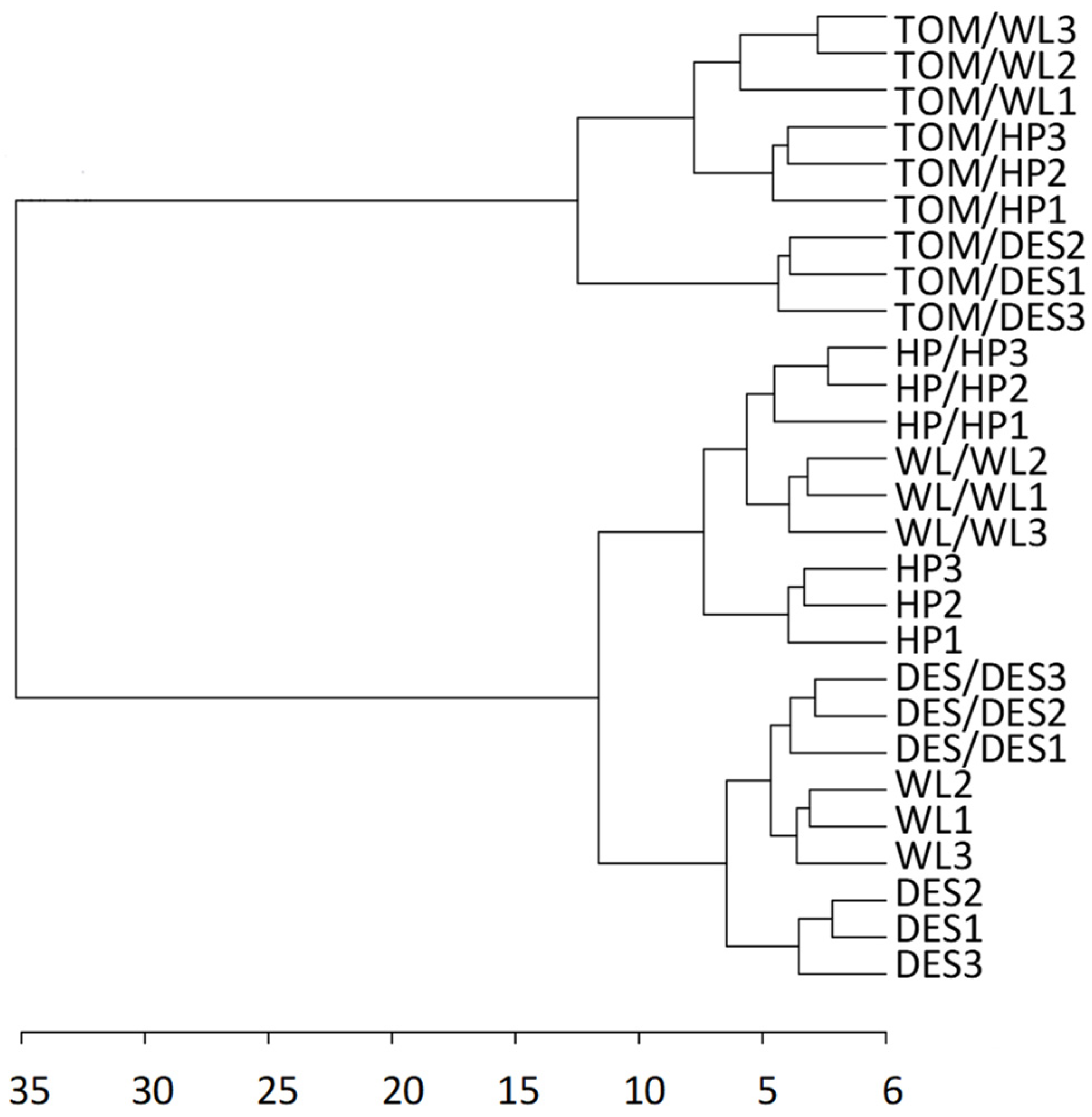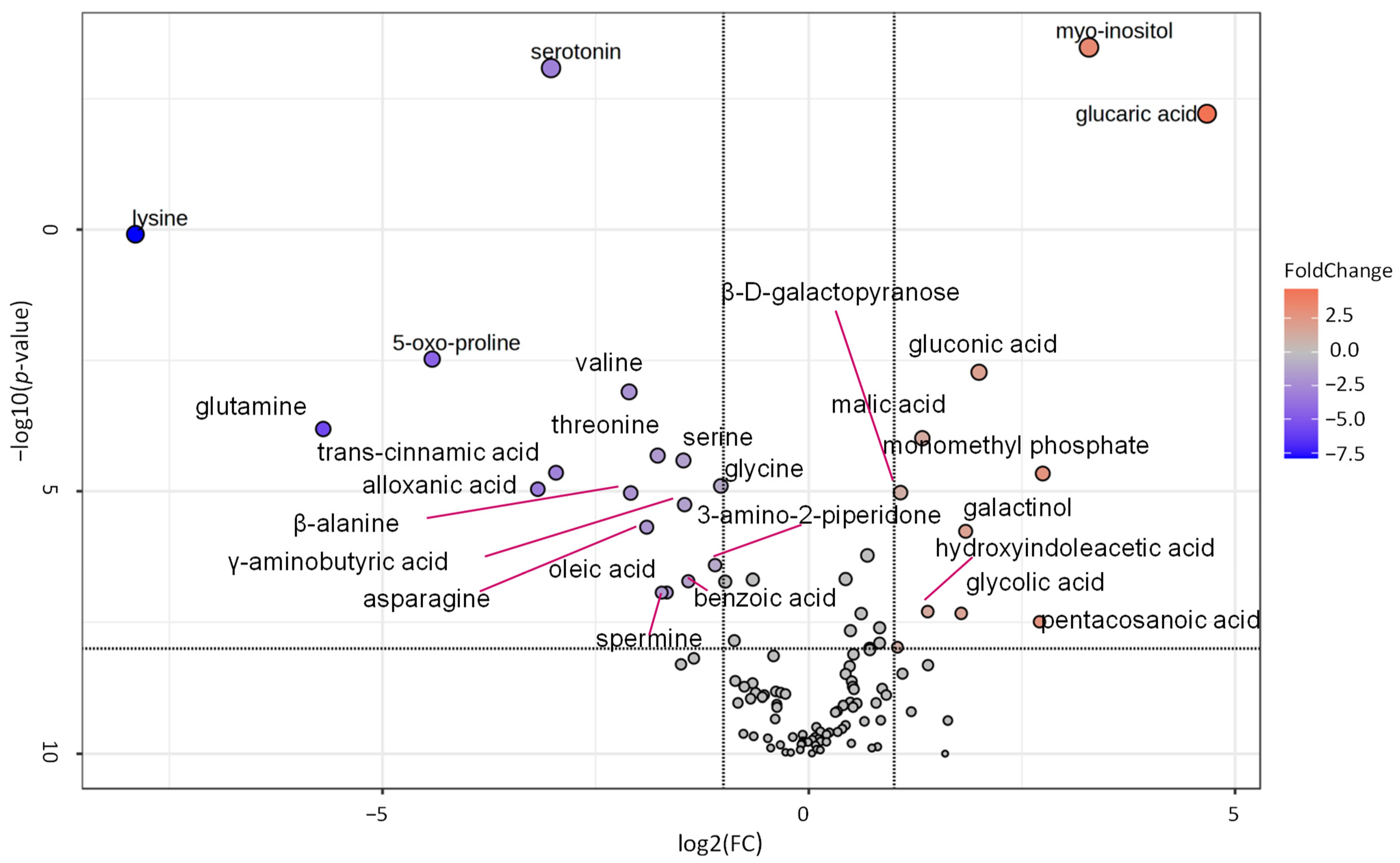Impact of Tomato Grafts on the Potato Tuber Metabolome and Skin Colour
Abstract
:1. Introduction
2. Materials and Methods
2.1. Plant Materials and Growth Conditions
2.2. Metabolite Extraction and Profiling
2.3. Data Transformation and Metabolite Identification
2.4. Determination of the Starch Content
2.5. Determination of the Protein Content
2.6. Determination of the Total Anthocyanin Content
2.7. Sucrose Treatment of In Vitro-Grown Potato Plants
2.8. Gene Expression Analysis
2.9. Statistics
3. Results
3.1. Morphological Characteristics of the Tubers Grown on Tomato/Potato Grafts
3.2. Metabolite Composition of Tubers Grown on Tomato/Potato Grafts
3.3. Pathways Altered in Tubers Grown on Tomato/Potato Grafts
3.4. Starch and Protein Contents of Tubers Grown on Tomato/Potato Grafts
3.5. Anthocyanin Content and Expression of StAN1 in the Tuber Skin of Tomato/Potato Grafts
4. Discussion
5. Conclusions
Author Contributions
Funding
Data Availability Statement
Acknowledgments
Conflicts of Interest
References
- Nie, W.; Wen, D. Study on the applications and regulatory mechanisms of grafting on vegetables. Plants 2023, 12, 2822. [Google Scholar] [CrossRef] [PubMed]
- Melnyk, C.W. Plant grafting: Insights into tissue regeneration. Regeneration 2017, 4, 3–14. [Google Scholar] [CrossRef]
- Bond, T.E.T. Phytophthora infestans (mont.) debary and Cladosporium fulvum cooke on varieties of tomato and potato and on grafted solanaceous plants. Ann. Appl. Biol. 1936, 23, 11–29. [Google Scholar] [CrossRef]
- Mai, W.F. Virus X in the newer potato varieties and the transmission of this virus by the cutting knife. Am. Potato J. 1947, 24, 341–351. [Google Scholar] [CrossRef]
- Raymer, W.B.; O’Brien, M.J. Transmission of potato spindle tuber virus to tomato. Am. Potato J. 1962, 39, 401–408. [Google Scholar] [CrossRef]
- Ulrychová, M.; Limberk, J. Some factors affecting the spread of mycoplasma in plants. Biol. Plant. 1972, 14, 238–240. [Google Scholar] [CrossRef]
- Khan, A.; Sagar, G.R. Alteration of the pattern of distribution of photosynthetic products in the tomato by manipulation of the plant. Ann. Bot. 1969, 33, 753–762. [Google Scholar] [CrossRef]
- Bünemann, G.; Grassia, A. Growth and mineral distribution in grafted tomato/potato plants according to sink number. Sci. Hortic. 1973, 1, 13–24. [Google Scholar] [CrossRef]
- Mill, J.G. Distribution of steroidal glycoalkaloids in reciprocal grafts of Solanum tuberosum L. and Lycopersion esculentum Mill. Experientia 1982, 38, 460–462. [Google Scholar] [CrossRef]
- Tsror, L.; Nachmias, A. Significance of the root system in verticillium wilt tolerance in potato and resistance in tomato. Israel J. Plant Sci. 1995, 43, 315–323. [Google Scholar]
- Barker, H. Inheritance of resistance to potato viruses Y and A in progeny obtained from potato cultivars containing gene Ry: Evidence for a new gene for extreme resistance to PVA. Theor. Appl. Genet. 1997, 95, 1258–1262. [Google Scholar] [CrossRef]
- Peres, L.E.P.; Carvalho, R.F.; Zsögön, A.; Bermúdez-Zambrano, O.D.; Robles, W.G.R.; Tavares, S. Grafting of tomato mutants onto potato rootstocks: An approach to study leaf-derived signaling on tuberization. Plant Sci. 2005, 169, 680–688. [Google Scholar] [CrossRef]
- Negi, V.; Sharma, P.; Raj, D.; Singh, A.; Vats, B. Horticultural and yield related traits as influenced by grafting tomato cultivars on potato rootstocks for higher returns. Indian J. Ecol. 2017, 44, 364368. [Google Scholar]
- Arefin, S.M.A.; Zeba, N.; Solaiman, A.H.; Naznin, M.T.; Azad, M.O.K.; Tabassum, M.; Park, C.H. Evaluation of compatibility, growth characteristics, and yield of tomato grafted on potato (‘pomato’). Horticulturae 2019, 5, 37. [Google Scholar] [CrossRef]
- Zhang, G.; Guo, H. Effects of tomato and potato heterografting on photosynthesis, quality and yield of grafted parents. Hortic. Environ. Biotechnol. 2019, 60, 9–18. [Google Scholar] [CrossRef]
- Zhang, G.; Mao, Z.; Wang, Q.; Song, J.; Nie, X.; Wang, T.; Zhang, H.; Guo, H. Comprehensive transcriptome profiling and phenotyping of rootstock and scion in a tomato/potato heterografting system. Physiol. Plant. 2019, 166, 833–847. [Google Scholar] [CrossRef]
- Murashige, T.; Skoog, F. A revised medium for rapid growth and bio assays with tobacco tissue cultures. Plant Physiol. 1962, 15, 473–497. [Google Scholar] [CrossRef]
- Villányi, V.; Gondor, O.K.; Bánfalvi, Z. Metabolite profiling of tubers of an early- and a late-maturing potato line and their grafts. Metabolomics 2022, 18, 88. [Google Scholar] [CrossRef]
- Shepherd, T.; Dobson, G.; Verral, S.R.; Conner, S.; Griffiths, D.W.; McNicol, J.W.; Davies, H.V.; Stewart, D. Potato metabolomics by GC–MS: What are the limiting factors? Metabolomics 2007, 3, 475–488. [Google Scholar] [CrossRef]
- Lewis, C.E. Anthocyanins and Related Compounds in Potatoes (Solanum tuberosum L.). Ph.D. Dissertation, University of Canterbury, Christchurch, New Zealand, 1996; pp. 205–206. [Google Scholar]
- Bradford, M. A rapid and sensitive method for the quantitation of microgram quantities of protein utilizing the principle of protein-dye binding. Anal. Biochem. 1976, 72, 248–254. [Google Scholar] [CrossRef]
- Toguri, T.; Umemoto, N.; Kobayashi, O.; Ohtani, T. Activation of anthocyanin synthesis genes by white light in eggplant hypocotyl tissues, and identification of an inducible P-450 cDNA. Plant Mol. Biol. 1993, 23, 933–946. [Google Scholar] [CrossRef] [PubMed]
- Payyavula, R.S.; Singh, R.K.; Navarre, D.A. Transcription factors, sucrose, and sucrose metabolic genes interact to regulate potato phenylpropanoid metabolism. J. Exp. Bot. 2013, 64, 5115–5131. [Google Scholar] [CrossRef]
- Stiekema, W.J.; Heidekamp, F.; Dirkse, W.G.; van Beckum, J.; de Haan, P.; Bosch, C.T.; Louwerse, J.D. Molecular cloning and analysis of four potato tuber mRNAs. Plant Mol. Biol. 1988, 11, 255–269. [Google Scholar] [CrossRef]
- Rio, D.C.; Ares, M.; Hannon, G.J.; Nilsen, T.W. Purification of RNA using TRIzol (TRI Reagent). Cold Spring Harb. Protoc. 2010, 2010, 5439. [Google Scholar] [CrossRef]
- Nicot, N.; Hausman, J.F.; Hoffmann, L.; Evers, D. Housekeeping gene selection for real-time RT-PCR normalization in potato during biotic and abiotic stress. J. Exp. Bot. 2005, 56, 2907–2914. [Google Scholar] [CrossRef]
- Roessner, U.; Wagner, C.; Kopka, J.; Trethewey, R.N.; Willmitzer, L. Simultaneous analysis of metabolites in potato tuber by gas chromatography-mass spectrometry. Plant J. 2000, 23, 131–142. [Google Scholar] [CrossRef]
- Uri, C.; Juhász, Z.; Polgár, Z.; Bánfalvi, Z. A GC-MS-based metabolomics study on the tubers of commercial potato cultivars upon storage. Food Chem. 2014, 159, 287–292. [Google Scholar] [CrossRef]
- Odgerel, K.; Bánfalvi, Z. Metabolite analysis of tubers and leaves of two potato cultivars and their grafts. PLoS ONE 2021, 16, e0250858. [Google Scholar] [CrossRef]
- Fiehn, O.; Kopka, J.; Dörmann, P.; Altmann, T.; Trethewey, R.N.; Willmitzer, L. Metabolite profiling for plant functional genomics. Nat. Biotechnol. 2000, 18, 1157–1161. [Google Scholar] [CrossRef]
- Geigenberger, P.; Stitt, M.; Fernie, A.R. Metabolic control analysis and regulation of the conversion of sucrose to starch in growing potato tubers. Plant Cell Environ. 2004, 27, 655–673. [Google Scholar] [CrossRef]
- Halford, N.G.; Raffan, S.; Oddy, J. Progress towards the production of potatoes and cereals with low acrylamide-forming potential. Curr. Opin. Food Sci. 2022, 47, 100887. [Google Scholar] [CrossRef]
- Wu, Y.; Han, T.; Lyu, L.; Li, W.; Wu, W. Research progress in understanding the biosynthesis and regulation of plant anthocyanins. Sci. Hortic. 2023, 321, 112374. [Google Scholar] [CrossRef]
- Liu, Y.; Tikunov, Y.; Schouten, R.E.; Marcelis, L.F.M.; Visser, R.G.F.; Bovy, A. Anthocyanin biosynthesis and degradation mechanisms in solanaceous vegetables: A review. Front. Chem. 2018, 6, 52. [Google Scholar] [CrossRef]
- Strygina, K.V.; Alex, V.; Kochetov, A.V.; Khlestkina, E.K. Genetic control of anthocyanin pigmentation of potato tissues. BMC Genet. 2019, 20, 27. [Google Scholar] [CrossRef]
- Albert, N.W.; Lewis, D.H.; Zhang, H.; Schwinn, K.E.; Jameson, P.E.; Davies, K.M. Members of an R2R3-MYB transcription factor family in Petunia are developmentally and environmentally regulated to control complex floral and vegetative pigmentation patterning. Plant J. 2011, 65, 771–784. [Google Scholar] [CrossRef]
- van Eck, H.J.; Jacobs, J.M.; Stam, P.; Ton, J.; Stiekema, W.J.; Jacobsen, E. Multiple alleles for tuber shape in diploid potato detected by qualitative and quantitative genetic analysis using RFLPs. Genetics 1994, 137, 303–309. [Google Scholar] [CrossRef]
- Wu, S.; Zhang, B.; Keyhaninejad, N.; Rodríguez, G.R.; Kim, H.J.; Chakrabarti, M.; Illa-Berenguer, E.; Taitano, N.K.; Gonzalo, M.J.; Díaz, A.; et al. A common genetic mechanism underlies morphological diversity in fruits and other plant organs. Nat. Commun. 2018, 9, 4734. [Google Scholar] [CrossRef]
- Ai, J.; Wang, Y.; Yan, Y.; Li, C.; Luo, W.; Ma, L.; Shang, Y.; Gao, D. StOFP20 regulates tuber shape and interacts with TONNEAU1 recruiting motif proteins in potato. J. Integr. Agric. 2023, 22, 752–776. [Google Scholar] [CrossRef]









| Graft Combinations | Number of Plants | Number of Survived Plants | Tuber Number/Plant | Tuber Mass/Plant (g) | Average Tuber Mass (g) | Number of Tubers ≥ 2 cm Width | Tuber Width/Length Ratio |
|---|---|---|---|---|---|---|---|
| WL | 8 | 8 | 3.8 ± 1.1 a | 31.5 ± 5.4 a | 8.3 ± 1.7 a | 20 | 0.69 ± 0.06 a |
| WL/WL | 12 | 12 | 2.8 ± 0.7 a | 23.6 ± 7.8 b | 8.4 ± 0.8 a | 20 | 0.69 ± 0.08 a |
| TOM/WL | 20 | 20 | 1.1 ± 0.2 b | 11.0 ± 3.3 c | 10.0 ± 0.6 b | 11 | 0.76 ± 0.06 b |
| HP | 8 | 7 | 3.0 ± 0.3 a | 30.1 ± 6.9 a | 10.0 ± 0.4 b | 12 | 0.80 ± 0.10 b |
| HP/HP | 12 | 12 | 1.8 ± 0.4 c | 24.1 ± 7.4 b | 11.4 ± 0.7 b | 14 | 0.70 ± 0.08 c |
| TOM/HP | 20 | 17 | 1.7 ± 0.3 c | 16.9 ± 5.1 c | 9.9 ± 0.5 b | 15 | 0.92 ± 0.05 d |
| DES | 8 | 8 | 2.8 ± 1.1 a | 29.2 ± 5.9 a | 10.4 ± 1.9 b | 16 | 0.64 ± 0.11 a |
| DES/DES | 12 | 12 | 2.1 ± 0.9 ac | 21.9 ± 5.9 b | 10.4 ± 1.6 b | 15 | 0.60 ± 0.12 a |
| TOM/DES | 20 | 18 | 1.2 ± 0.6 b | 16.1 ± 5.3 c | 13.4 ± 1.5 c | 16 | 0.79 ± 0.07 b |
Disclaimer/Publisher’s Note: The statements, opinions and data contained in all publications are solely those of the individual author(s) and contributor(s) and not of MDPI and/or the editor(s). MDPI and/or the editor(s) disclaim responsibility for any injury to people or property resulting from any ideas, methods, instructions or products referred to in the content. |
© 2024 by the authors. Licensee MDPI, Basel, Switzerland. This article is an open access article distributed under the terms and conditions of the Creative Commons Attribution (CC BY) license (https://creativecommons.org/licenses/by/4.0/).
Share and Cite
Villányi, V.; Odgerel, K.; Okaroni, C.O.; Bánfalvi, Z. Impact of Tomato Grafts on the Potato Tuber Metabolome and Skin Colour. Int. J. Plant Biol. 2024, 15, 517-533. https://doi.org/10.3390/ijpb15030039
Villányi V, Odgerel K, Okaroni CO, Bánfalvi Z. Impact of Tomato Grafts on the Potato Tuber Metabolome and Skin Colour. International Journal of Plant Biology. 2024; 15(3):517-533. https://doi.org/10.3390/ijpb15030039
Chicago/Turabian StyleVillányi, Vanda, Khongorzul Odgerel, Cathrine O. Okaroni, and Zsófia Bánfalvi. 2024. "Impact of Tomato Grafts on the Potato Tuber Metabolome and Skin Colour" International Journal of Plant Biology 15, no. 3: 517-533. https://doi.org/10.3390/ijpb15030039
APA StyleVillányi, V., Odgerel, K., Okaroni, C. O., & Bánfalvi, Z. (2024). Impact of Tomato Grafts on the Potato Tuber Metabolome and Skin Colour. International Journal of Plant Biology, 15(3), 517-533. https://doi.org/10.3390/ijpb15030039







